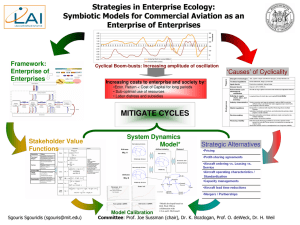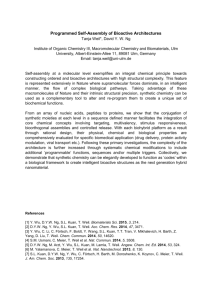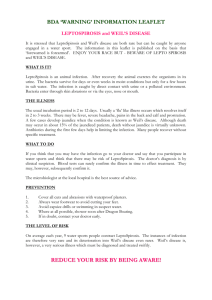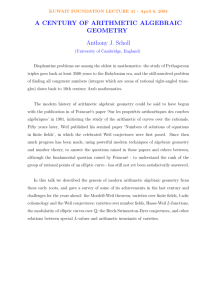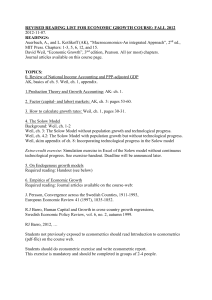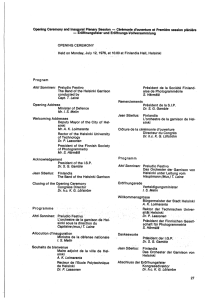RESEARCH STATEMENT
advertisement
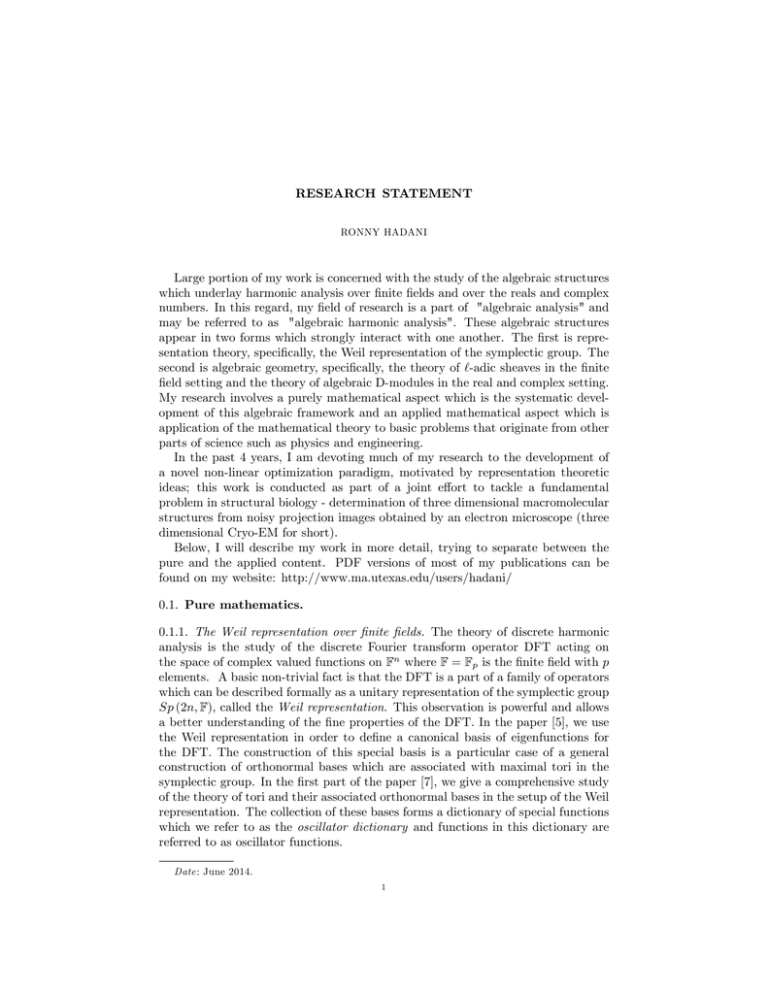
RESEARCH STATEMENT RONNY HADANI Large portion of my work is concerned with the study of the algebraic structures which underlay harmonic analysis over …nite …elds and over the reals and complex numbers. In this regard, my …eld of research is a part of "algebraic analysis" and may be referred to as "algebraic harmonic analysis". These algebraic structures appear in two forms which strongly interact with one another. The …rst is representation theory, speci…cally, the Weil representation of the symplectic group. The second is algebraic geometry, speci…cally, the theory of `-adic sheaves in the …nite …eld setting and the theory of algebraic D-modules in the real and complex setting. My research involves a purely mathematical aspect which is the systematic development of this algebraic framework and an applied mathematical aspect which is application of the mathematical theory to basic problems that originate from other parts of science such as physics and engineering. In the past 4 years, I am devoting much of my research to the development of a novel non-linear optimization paradigm, motivated by representation theoretic ideas; this work is conducted as part of a joint e¤ort to tackle a fundamental problem in structural biology - determination of three dimensional macromolecular structures from noisy projection images obtained by an electron microscope (three dimensional Cryo-EM for short). Below, I will describe my work in more detail, trying to separate between the pure and the applied content. PDF versions of most of my publications can be found on my website: http://www.ma.utexas.edu/users/hadani/ 0.1. Pure mathematics. 0.1.1. The Weil representation over …nite …elds. The theory of discrete harmonic analysis is the study of the discrete Fourier transform operator DFT acting on the space of complex valued functions on Fn where F = Fp is the …nite …eld with p elements. A basic non-trivial fact is that the DFT is a part of a family of operators which can be described formally as a unitary representation of the symplectic group Sp (2n; F), called the Weil representation. This observation is powerful and allows a better understanding of the …ne properties of the DFT. In the paper [5], we use the Weil representation in order to de…ne a canonical basis of eigenfunctions for the DFT. The construction of this special basis is a particular case of a general construction of orthonormal bases which are associated with maximal tori in the symplectic group. In the …rst part of the paper [7], we give a comprehensive study of the theory of tori and their associated orthonormal bases in the setup of the Weil representation. The collection of these bases forms a dictionary of special functions which we refer to as the oscillator dictionary and functions in this dictionary are referred to as oscillator functions. Date : June 2014. 1 2 RONNY HADANI The oscillator functions are interesting objects of study on their own right, roughly, they share many properties which are characteristic to random functions. A quantitative study of these properties requires the use of algebraic geometry and is given in the second part of [7]. The main tool that we use is an algebra-geometric counterpart (an `-adic sheaf) of the Weil representation, which we refer to as the geometric Weil representation. In [8], we construct the geometric Weil representation. Our construction elaborates on a previous construction due to Deligne [4]. There are two main advantages of the geometric Weil representation. First it allows to treat split and non-split situations on an equal footing. Second, it allows to recast problems of representation theory and harmonic analysis in the language of algebraic geometry, and then to approach them using cohomological techniques. In [9], we take advantage of these two attributes of the geometric Weil representation in order to prove the Kurlberg-Rudnick conjecture from arithmetic quantum chaos. This conjecture concerns the rate of convergence of the semi-classical limit of a certain matrix coe¢ cients associated with eigenfunctions of quantized chaotic Hamiltonians in the Berry Hannay model of quantum mechanics. When p is equal two, namely, the …eld F is of characteristic 2, the structure of the Weil representation changes dramatically and, in particular, it is no longer a representation of the symplectic group Sp (2n; F). This fact implies that the theory of harmonic analysis in characteristic 2 is di¤erent than in odd characteristic. In [10], we construct the Weil representation in characteristic 2. Our construction improves upon Weil’s classical construction from [27] in two aspects: First, our version is a representation of a bigger group which contains Weil’s pseudo symplectic group as a strict subgroup. Second, our construction is based on the method of canonical vector spaces, what makes it more functorial and transparent. In the future, we intend to use this construction in order to study the …ne aspects of the Weil representation in characteristic 2, in particular we plan to develop an e¤ective theory of dual pairs (see [20]). Another direction of future research concerns geometrization, that is, constructing, like in odd characteristic, an algebrageometric counterpart of the Weil representation in characteristic 2. Here, there is a preliminary di¢ culty since, in characteristic 2, the metaplectic sign appears already in the …nite level, which implies a conceptual di¢ culty in the de…nition of the geometric object which is probably an algebraic group stack instead of algebraic group variety as in the case of odd characteristic. The traditional construction of the Weil representation is highly implicit. The ideology, due to Kazhdan, behind the formalism of canonical vector spaces is that there exists a natural vector space on which the action can be transparently described. In [11], the formalism of canonical vector spaces is developed for p odd. The statement is that the Weil representation is governed by a more fundamental object which is a quantization functor from the category of symplectic vector spaces over F to the Category of complex vector spaces. This approach to the Weil representation is explicit (no complicated formulas), moreover, it reveals additional algebraic structures which exists in the setting of discrete harmonic analysis which are not so evident from the traditional perspective. In [2], we construct an algebro-geometric/categorical counterpart of this quantization functor. In this categorical context we propose a solution to a question of Joseph Bernstein concerning the vanishing (triviality) of the metaplectic sign in the categorical setting. In the RONNY HADANI 3 future, we intend to develop further this formalism, …rst over …nite …elds of odd characteristic, then, in characteristics two and over in…nite …elds such as the reals and the p-adic …elds. The Weil representation of SL (2; F) and, more generally, the Weil representation of SL (2; Z=nZ) for any n 2 N, is a fundamental object in number theory. In [12], we use the Weil representation of SL (2; Z=nZ) in order to give a new proof of two classical results in number theory (both due to Gauss) - the quadratic reciprocity law and the sign of Gauss sum. Our approach should be contrasted with Weil’s work [27], where he recasts several known proofs of the law of quadratic reciprocity in terms of the Weil representation of a certain cover of the group SL(2; AQ ) where AQ denotes the adele ring of Q: In this regard, we show that quadratic reciprocity already follows from the Weil representation over …nite rings and, moreover, we establish a conceptual mechanism, di¤erent from that of Weil, which implies the law of quadratic reciprocity. 0.1.2. The Weil representation over the reals. In the real setting, the Fourier transform is a particular operator in the Weil representation of the metaplectic1 group M p (2n; R). In addition, it is intimately associated with the Hilbertian space of Schwartz functions on Rn . In [17], we develop a D-module theoretic interpretation of the Weil representation; in addition, we characterize the Schwartz space as the space of global solutions of a certain (twisted) D-module, which we refer to as the Weil D-module. This approach allows to de…ne various local versions of the Schwartz space which we refer to as local Schwartz spaces. Another advantage of the D-module framework is that it allows to naturally incorporate powerful methods from homological algebra in the setting of real harmonic analysis. The main goal of [17] is to suggest an answer to a question of Deligne (see [3]) concerning the possible existence of a canonical pairing between certain pairs of local Schwartz spaces. The construction of the pairing uses the Green class of the Weil D-module, where, the notion of a Green class of a D-module is a generalization of the classical notion of Green form of a linear di¤erential operator (see [15]). Another application of the Green class of the Weil D-module is to de…ne reconstruction formulas generalizing the Fourier inversion formula (see below). The Weil D-module constitutes the algebraic structure underlying real harmonic analysis, much in the same way that the Cauchy Riemann equations underlay complex analysis. The twist in the de…nition of the Weil D-module is the algebraic origin of the metaplectic sign (see [24]). Also, the Weil D-module should be considered as the real counterpart of the geometric Weil representation from the …nite …eld setting. We intend to develop the D-module framework further to account, in particular, for the theory of dual pairs in Sp (2n; R), which consequently, may have application to the theory of automorphic forms and automorphic representations. In addition, many equations from classical and quantum physics can be recasted in the language of the Weil representation using the theory of dual pairs (see [20]); few examples are: The wave equation, Laplace equation, Maxwell equations and Dirac equation. An interesting direction for future research is to understand these equations and their solutions in the D-module theoretic framework. 0.2. Applied mathematics. 1 The metaplectic group M p (2n; R) is a double cover of the symplectic group Sp (2n; R). 4 RONNY HADANI 0.2.1. Three dimensional cryo-electron microscopy. Three dimensional cryo-electron microscopy (3D cryo-EM for short) is the problem of reconstructing the three dimensional structure of large molecules from the images obtained by an electron microscope. Three dimensional reconstruction from Cryo-EM images is of particular interest because it promises to be an entirely general technique that does not require crystallization or other special preparation stages; it is beginning to reach su¢ cient resolution to allow the trace of polypeptide chains and the identi…cation of residues in protein molecules [18, 23, 29]. In a nutshell, the experimental set-up is an electron-microscope projecting a high energy electron beam through a thin layer of ice consisting of multitude of identical molecules, immobilized in random orientations. The beam interacts separately with each of the molecules and results with a (raw) projection image encoding the di¤raction pattern (mathematically, these images corresponds to the X-ray transform projections of the molecule). In this way, one ends up with a very large collection of raw projection images, each associated with a di¤erent molecule in the ice, and the goal is to reconstruct from these images the 3D structure of the basic molecule. There are two main di¢ culties involved: (1) The …rst di¢ culty is that the projection images are extremely noisy (due to the low electron dose that can interact with each molecule before it is destroyed). (2) The second is that the orientations of the molecules that produced every image is unknown (unlike crystallography where the molecules are packed in a form of a crystal and therefore share the same known orientation). Overcoming these two di¢ culties are principal challenges in the science of CryoEM. In [25], Singer and Shkolnisky introduced a novel algorithm for overcoming the second di¢ culty, referred to as the intrinsic reconstitution algorithm. Their algorithm has the appealing property of exhibiting remarkable numerical stability to noise and, as it turns out, leverages an interesting algebraic structure lying in the fabric of Cryo-EM and many other optimization problems. In [21], we revealed this formal algebraic structure and used it in order to provide a conceptual explanation for the admissibility (correctness) of the algorithm and a proof of its numerical stability. In [22], we furthered developed that algebraic structure as part of a novel algorithm for overcoming the …rst di¢ culty, that is, the problem of denoising. Specificaly we solved the problem of class averaging, that is, clustering together raw projection images that originate from similar viewing directions. After classi…cation, images in the same class are rotationally aligned with respect to one another and super-imposed to yield denoised images (class averages) enjoying higher SNR. These better quality images can be processed, for example, by the intrinsic reconstitution algorithm, which places every image in its appropriate place in the 3D space and after application of the inverse X-ray transform obtain a 3D structure determinaiton. A detailed study of this new algorithm class averaging is given in [26]. I am currently working, jointly with Gurevich and Singer, [14], on a far reaching generalization of the intrinsic reconstitution algorithm to the case of symmetric molecules. In the course of this work, we are laying down the mathematical foundations of a novel non-linear optimization paradigm, motivated by group representation theoretic ideas, that enables to obtain a numerically stable solution to the RONNY HADANI 5 various aspects of the three dimensional Cryo-EM problem and probably to many other di¢ cult non-linear optimization problems. In a nutshell, the paradigm shift is that the output of a standard optimization algorithm is an element of a set, while the output of our algorithms is an object in a category. We refer to this new paradigm as categorical optimization. To give an example: for the case of the intrinsic reconstitution algorithm, namely orientation reconstruction of molecules with trivial symmetries. The output of the algorithm is a three dimensional vector space V, equipped with a collection of frames (orthonormal bases) 'i in V, each associated with a di¤erent projection image i. The sense by which this constitute a solution for the computational problem is that there exists an isomorphism from V to R3 that identi…es the frames 'i with the actual orientations of the molecules. For the more general case of orientation reconstruction of molecules with non trivial symmetries. The output of the algorithm is a graded algebra A, equipped with a collection of characters 'i , each associated with a di¤erent projection image i. I am also, currently working with my students on applications of categorical optimization to the problem of denoising the raw Cryo-EM images, a method which constitutes an interesting/complementary alternative to class averaging. We believe that this method will be applicable to other denosing problems,which are not related to Cryo-EM, as well. 0.2.2. Applications to digital signal processing. The …eld of digital signal processing (DSP for short) studies the space of digital signals (…nite sequences) which is the Hilbert space H of complex valued functions on Fn , for n 2 N. The basic observation is that this space should be considered as a representation space acted upon by the group Sp (2n; F) via the Weil representation : Sp (2n; F) ! U (H) . In this regard, the Weil representation establishes the bridge between DSP and representation theory. A basic problem in DSP is to construct interesting and useful dictionaries of signals which satisfy various properties which appear in the engineering wish list. There are few mathematical constructions of such dictionaries; representation theory is one of these few. In [7], we use the Weil representation in order to construct the oscillator dictionary (see more details above); we prove that the oscillator functions satisfy properties which makes them ideal for applications to the theory of discrete radar (see [19]) and communication theory (see [16]), particularly CDMA systems. Currently, we develop the theory of the oscillator dictionary further in several directions: One direction of research concerns the algorithmic aspect of the construction which becomes crucial in "real life" applications. Another important direction of research concerns the relation between the discrete theory (digital signals) and the continuos theory (analog signals); this concerns the systematic study of discretization operators translating from the continuos to the discrete and lifting operators translating from the discrete to the continuos; from the representation theoretic point of view its the relation between the Weil representation of the group Sp (2n; F) and the Weil representation of the group Sp (2n; R) that we want to study. The oscillator dictionary has a particular form, its a disjoint union of orthonormal bases such that functions from di¤erent bases are almost orthogonal to one another. Such a system of orthonormal bases is called an incoherent system. Incoherent 6 RONNY HADANI systems are rigid objects and seem to play a fundamental role in DSP; there are few mathematical constructions of such systems and in most constructions that we know the incoherence property is accounted by deep results from algebraic geometry. In [13], we study the statistical properties of incoherent systems, in particular, we prove that an incoherent system satisfy a statistical version of the restricted isometry property (RIP for short) which appears to be useful in applications related to sparsity. Currently, we study an application of the oscillator dictionary to holography. Roughly, an holographic representation of a signal ' is an orthonormal basis such that the coe¢ cients of ' in the linear expansion with respect to this basis are approximately of the same absolute value; such representations appear to be important in massive communication channels. In principle, one can use an orthonormal basis of random functions to obtain an holographic representation, however, the disadvantage is, that the computation of the transition matrix takes order of N 2 operations, where N = dim H. Oscillator functions behave very much like random functions, moreover, in [5], we explain that, in certain cases, the transition matrix with respect to an orthonormal basis of oscillator functions can be computed in order of N log (N ) operations. In this regard, basis of oscillator functions may be viewed as a basis of random functions with good computational attributes. In [6], we use the Oscillator functions (based on the Weil representation) in combination with "Chirp" functions (based on the Heisenberg representation) in order to construct novel pilot signals for fast channel estimation/acquisition. High resolution and computationally e¢ cient channel acquisition is a pivotal problem in communication where precise and complete channel state information is crucial for reliable equalizaiton in high rate communication links and also to (delay Doppler) radar applications where real time estimation of multiple targets position and velocity is required. 0.2.3. Applications to analog signal processing. The …eld of analog signal processing (ASP for short) studies the space of analog signals which is the Hilbertian space S of Schwartz functions on Rn , for n 2 N, which should be considered as a representation space of the metaplectic group M p (2n; R) acting via the Weil representation : M p (2n; R) ! U (S) : An analog signal ' can be e¤ectively reconstructed from its Fourier transform ' b using the Fourier inversion formula. More generally, it can be e¤ectively reconstructed from 'g = (g) ', for any g 2 M p (2n; R) as ' = g 1 'g . We are currently studying general reconstruction formulas which can be de…ned using the Green class of the Weil D-module [17] (see above). These formulas are cohomological in nature and constitute a far reaching generalization of the Fourier inversion formula and its variants. Very roughly, the result is that a signal ' can be e¤ectively reconstructed from the collection of values f'g (x) : (g; x) 2 Xg where X is any submanifold of dimension n of M p (2n; R) Rn , satisfying some mild properties. In the future, we intend to study applications of these new reconstruction formulas to signal processing and wave optics. References [1] Beilinson A., Bernstein J., A proof of Jantzen conjecture. I.M. Gelfand seminar, 1–50, Adv. Soviet Math.,16 part 1. RONNY HADANI 7 [2] Gurevich S., Hadani R., The Categorical Weil Representation. Journal Of Symplectic Geometry (2014). [3] Deligne P., Groupe de Heisenberg et rèalité (French), J. Amer. Math. Soc. 4 (1991), no 1, 197–206. [4] Deligne P., Metaplectique. A letter to Kazhdan (1982). [5] Gurevich S. and Hadani R., On the diagonalization of the discrete Fourier transform. Applied and Computational Harmonic Analysis (2009). [6] Fish A., Gurevich S., Hadani R., Sayeed A., and Schwartz O. - Delay-Doppler Channel Estimation with Almost Linear Complexity . IEEE Transaction on Information Theory. Volume 59, Issue 11, 7632-7644 (2013). [7] Gurevich S., Hadani R. and Sochen N., The …nite harmonic oscillator and its application to sequences, communication and radar. IEEE Transaction on Information Theory (2008). [8] Gurevich S. and Hadani R., The geometric Weil representation. Selecta Mathematica, New Series, 13 (3), 465-481 (2007). [9] Gurevich S. and Hadani R., Proof of the Kurlberg-Rudnick rate conjecture. Annals of Mathematics (2011). [10] Gurevich S. and Hadani R. The Weil representation in characteristic two. Advances In Mathematics (2012). [11] Gurevich S. and Hadani R., Quantization of symplectic vector spaces over …nite …elds. Journal of symplectic geometry (2009). [12] Gurevich S., Hadani R. and Howe R., Quadratic reciprocity and sign of Gauss sum via the …nite Weil representation. International Mathematics Research Notices (IMRN) Vol. 19, 3729-3745, (2010). [13] Gurevich S. and Hadani R., Incoherent dictionaries and the statistical restricted isometry property. Preprint (2009). [14] Gurevich S., Hadani, R. and Singer A., Representation theoretic patterns in three dimensional cryo-electron macroscopy III - presence of point symmetries. In preperation. [15] Gonchaorov A., Di¤erential equations and integral geometry, Adv. Math. 131 (1997), no. 2, 279–343. [16] Golomb S.W. and Gong G., Signal design for good correlation. For wireless communication, cryptography, and radar. Cambridge University Press, Cambridge (2005). [17] Hadani R., The Weil representation over the complex numbers and localization of Schwartz spaces. Preprint. [18] Henderson, R., Realizing the potential of electron cryo-microscopy. Q Rev Biophys. 37(1):313. Review. PMID: 17390603 [PubMed - indexed for MEDLINE] (2004). [19] Howard S. D., Calderbank A. R. and Moran W., The …nite Heisenberg-Weyl groups in radar and communications. EURASIP J. Appl. Signal Process. (2006). [20] Howe R., Dual pairs in physics: harmonic oscillators, photons, electrons, and singletons. Applications of group theory in physics and mathematical physics (Chicago 1982), 179-207, Lectures in appl. Math., 21, Amer. Math. Soc., providence, RI (1985). [21] Hadani, R. and Singer, A., Representation theoretic patterns in three dimensional cryoelectron macroscopy I - The Intrinsic reconstitution algorithm. Annals of Mathematics (2011). [22] Hadani, R. and Singer, A., Representation theoretic patterns in three dimensional cryoelectron macroscopy II - The Class Averaging Problem. Foundations of Computational Mathematics (FoCM) (2011). [23] Ludtke, S. J., Baker, M. L., Chen, D.H., Song, J. L., Chuang, D. T., and Chiu, W., Denovo backbone trace of GroEL from single particle electron cryomicroscopy. Structure, 16(3):441448 (2008). [24] Lion G., Vergne M., The Weil representation, Maslov index and theta series. Progress in Mathematics, 6. Birkhäuser, Boston, Mass (1980). [25] Singer, A. and Shkolnisky, Y., Three-diemensional Structure Determination From Common Lines in Cryo-EM by Eigenvectors and Semide…nite Programming, Siam Journal of Imaging Sciences (2010). [26] Singer, A., Zhao Z., Shkolnisky Y. and Hadani R., Viewing Angle Classi…cation Of CryoElectron Microscopy Images Using Eigenvectors, Siam Journal on Imaging Science (2011). [27] Weil A., Sur certains groupes d’operateurs unitaires. Acta Math. 111 (1964), 143-211. 8 RONNY HADANI [28] Weinstein A., The symplectic "category". Di¤ erential geometric methods in mathematical physics. Lecture Notes in Math., 905, Springer, Berlin-New York (1982) 45–51. [29] Zhang, X., Settembre, E., Xu, C., Dormitzer, P. R., Harrison, S. C., and Grigorie¤, N., Near atomic resolution using electron cryomicroscopy and single particle reconstruction. Proceeding of the National Academy of Sciences (PNAS), 105(6):1867-1872 (2008).
